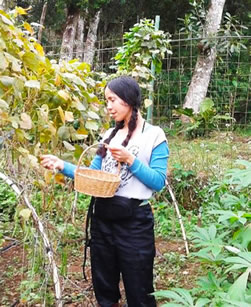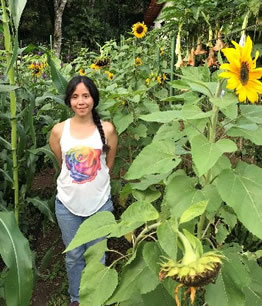Huerta Verde Esmeralda (“Emerald Green Garden”), (haga clic aquí para la versión en español) La Huerta Verde Esmeralda (“The Emerald Green Garden” (biointensivocentroamerica.com)) is a space for learning, experimentation and research for self-sufficiency and the dissemination of the GROW BIOINTENSIVE method! This Biointensive garden is in a mountainous area of the tropical humid forest climate transition to premontane at 1800 masl (5905 ft. elevation), near the small town of Copalchí in the province of Cartago, Costa Rica. It was created in 2016 and is managed by Ligia and Tania Espinoza Benavides, twin sisters of Nicaraguan origin now living in Costa Rica. In this article, they relate their experiences establishing Huerta Verde Esmeralda and what motivates them to have their own garden.
We are motivated by many things, but we will summarize them in three:
We grew up in a country under reconstruction after a war, where the availability of and access to quality food were limited for the majority of the population, and the form or productive strategies to solve the problem - which were established for business reasons to regenerate the economy— did not seem appropriate. We studied environmental quality engineering and understood that the impacts of agricultural and agro-industrial activity for export and import of products and supplies were destructive and unsustainable, and also their contribution to climate change was significant. So, searching for something we could do, on a personal level, to stop the destruction of the land and its natural resources—to help change the production and consumption paradigm, with a clear ecological focus—we changed our diet from omnivorous to vegetarian. In 2009, we eliminated the meats from our diet. Since then, we try to be responsible consumers, conscientiously choosing our foods, checking labels, and trying as far as possible to buy local and free of pesticides. This has not been easy because there are very few options available; for that reason, out of necessity, we decided to become organic farmers, because we had to create the options that did not exist to diversify our diet and generate our new, personalized lifestyle. In 2010, we met Juan Manuel Martínez, from the Mexican organization ECOPOL. Thanks to his noble energy and ability to inspire and teach, we trained at a basic level, learning the GROW BIOINTENSIVE method. We lived in the city, and we started our practice by installing and promoting small garden projects of 10 to 30 m2 (100-300 sq. ft.) in friends’ backyards and parks in our neighborhood and universities where we worked. In 2014, we finished the second growing season at the 30 m2 (300 sq. ft.) mini-farm we managed in Nicaragua, with the purpose of obtaining basic-level teacher certification in grow biointensive method (in the first official GROW BIOINTENSIVE teaching, demonstration and research center headquarters, located in the Universidad Nacional Agraria’s farm for validation of agricultural practices, established as a result of the collective work of a founding group of which we were also part) Tania and I had the opportunity to travel to California, with a scholarship from Ecology Action, to join their 6-month internship program in The Jeavons Center research and demonstration mini-farm. Through the internship program, we learned the basis of sustainable garden design – ecologically and economically – working in a closed-loop system, where all “waste” is reused to continually improve the soil and increase the efficiency and productivity of the system. Thanks to John Jeavons and Ecology Action’s team of enthusiastic people for practicing and teaching the method, we decided that we wanted to become biointensive ecologic farmers, producing the food we want and choose to consume, designing a diet to supply our caloric and nutritional requirements. Returning from California, we offered workshops and training meetings in Nicaragua, sharing the skills we gained during our internship with our colleagues in the Biointensive movement. We said goodbye to our previous work (university teaching and NGO service), and at the end of 2015 Tania and I moved to Costa Rica, where we found the right conditions to allow us to begin a life project: living the practice of growing food sovereignty and gradually breaking the paradigms of conventional and non-sustainable food production. In 2016 I married Makhno Mata, a Costa Rican plastic artist, and we established our home on the beautiful mountain where the family property we call Finca Ecológica Verde Esmeralda is located. Tania, Makhno and I are working together to turn the property into a model of food sovereignty that can generate transferable knowledge in technological tools, inputs and capacities, so that the model can be adopted, adapted, multiplied or replicated by the people who visit us to find personalized spaces in which to share, collaborate and learn. We created the Huerta Verde Esmeralda garden for the purpose of self-sufficiency and productive experimentation, to demonstrate that we could design sustainable ecological systems with closed-loop sustainability, high diversity and productivity, applying all the principles of the Biointensive method. Within the experimentation processes that we develop, our research is supported by the collection and analysis of crop data, which allows us to assess the efficiency of the production system and select the best crops to work in the climate and conditions of the mountain where we live. Starting a garden from zero, with not much but our own entrepreneurship – and in a new country! – is not an easy task. Access to water for irrigation was one of the most costly issues we had to deal with, but little by little, we figured it out. Our garden has been growing larger and we have installed facilities that makes our daily work more practical and efficient in time and energy consumption, both in productive aspects and for data recording. Thanks to cooperation and family support, we are increasingly closer to evolving the work in the garden, from self-sufficiency to the establishment of a research and teaching learning center. We are also interested in expanding work capacities in the farm in general, in aspects of protection and conservation of ecosystems, species and forest areas, as well as implementing ecological and sustainable technologies, which allow us to continuously improve the management of liquid and solid domestic waste. In 2019, in parallel to the productive development of our garden area, we are designing and establishing an edible forest, where we are also applying Biointensive and natural conservation principles by mixing various design techniques. At the moment, after 31/2 years of having established our garden on the farm, we estimate that we get 25-30% of our food from it, from a variety of crops including cereals, tubers, vegetables, legumes, aromatic herbs, medicinal plants and shrubs. We expect to increase that percentage every year as we increase our cultivation areas in proportion to the number of family members that we feed and our maintenance capacity, until we produce no less than 80% of our family diet. Most farmers in Costa Rica, Nicaragua and the region grow crops to sell, and then use the money they receive to buy food for themselves and their families. We, as Biointensive farmers, grow to eat healthy, nutritious food, taking care of the soil health and saving seed from the garden for the next growing cycle, exchanging or marketing, and we plan to sell only surpluses. Thus, we ensure that we produce and consume top quality and organic food that helps care for and conserve nature and does not exploit, abuse, or destroy it. The challenge of the sustainable farmer is to be creative, to diversify sources of income, and to be increasingly efficient and productive in the art of living in health, awareness and responsibility. There is much to learn and more road to travel; it is nature, animals and people we love who motivate us to make the journey. Esta huerta biointensiva está ubicada en una zona montañosa de clima de bosque húmedo tropical transición a premontano a 1800msnm, en las cercanías del pueblo de Copalchí en la provincia de Cartago, Costa Rica.
Fue creada en 2016 y es manejada por Ligia y Tania Espinoza Benavides, hermanas gemelas de origen nicaragüense residentes en Costa Rica, a continuación, nos cuentan su experiencia y lo que las motiva a tener su propia huerta. Nos motivan muchas cosas, las resumiremos en tres: la realidad socio ecológica, económica y política del planeta y de nuestra región de origen; personas que admiramos; y la necesidad de crear nuevos modelos y sistemas productivos para romper paradigmas que estancan a la humanidad y destruyen la naturaleza.
top | Newsletter Home |Table of Contents| Archive
|




